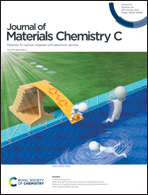Turning on high-rate-capability fluorescence resonance energy transfer in a quantum dot-molecule system via high pressure†
Abstract
Turning on fluorescence resonance energy transfer (FRET) based on a quantum dot (QD)-molecule system plays crucial roles in developing photovoltaic solar cells, optical biosensing schemes and light-emitting devices. The present achievement of turn-on FRET is restricted to the approach of only controlling the spectral overlap, which needs an efficient strategy to further accelerate the FRET process. Here, a new approach to turn on and facilitate the FRET process simultaneously in the CdSe/ZnS QD–Rhodamine640 system using an in situ high-pressure technology is introduced. On the basis of the pressure-tunable fluorescence spectrum of QDs, the use of high pressure yields a spectral overlap from none to appreciable, thus “turning on” the FRET process. Simultaneously, the pressure significantly reduces the donor–acceptor distance and increases the number of adsorbed acceptors, thus making the FRET process highly efficient and very rapid. The FRET rate at 3.6 GPa can reach up to 5 ps−1, which is a new record for spherical QD systems at present. This approach provided a new strategy for turning on and facilitating the FRET process, which is of significance in the development of potential QD-molecule-based FRET applications.



 Please wait while we load your content...
Please wait while we load your content...